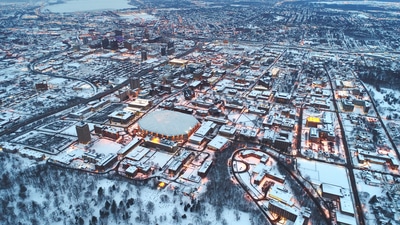
Have you ever been out in the bitter cold heaving shovel after shovel full of snow onto an ever-growing snowbank and thought to yourself, “there’s no way anyone gets more snow than we do?”
Have you ever read about a southern city getting shut down for a mere dusting and felt great pride in your town’s ability to handle your mountains of snow, surely bigger than anyone else’s? Many of us from the northern parts of the United States have experienced something like this. But where does it snow the most in the US? Read on as we explore the 11 snowiest cities in the US.
We use average annual snowfall data from the National Centers for Environmental Information (NCEI) to compile this list. Note that NCEI counts ice pellets (sleet) and hail as “snow,” though rarely do either fall in large enough quantities to produce accumulations meaningful for a long-term average. Also, for this list, only the snowiest cities with a population greater than 25,000 are considered.
What Conditions are Required to Produce Snow?
Like many atmospheric phenomena, snow requires a special set of ingredients to be present at a specific time and place. These ingredients are:
- Cold air (below 32° Fahrenheit or 0° Celsius)
- Moisture (relative humidity above 70-80%, usually)
- Rising air
All you need to do is assemble the three, and you can get snow!
How do these ingredients usually come together? It varies a lot by place. In the Rocky Mountains, high elevation ensures an abundant supply of cold air for much of the year. Moisture can arrive from the Pacific Ocean, and air must rise whenever it hits the mountains, so snowfall is easy to come by.
In the Midwest, cold air from Canada moves across the warm Great Lakes to produce bands of lake-effect snow. How does this happen? Warm air is less dense than cold air and will rise if located beneath colder air. When cold air masses come south out of Canada in the winter, a small layer of warm air adjacent to the Great Lakes is trapped beneath a much colder blanket of air from the north. This warm air, rich with moisture due to evaporation from the lakes, then rises (remember it is less dense than the surrounding cold air). As it rises, the lake air cools, which means it can hold less moisture, and any excess must fall out as rain or snow.
In the Northeast, intense coastal storms often called “nor’easters,” combine cold Canadian air and moisture from the Gulf of Mexico/Atlantic Ocean. When these very different air masses collide, the less dense air from the Gulf of Mexico (remember, warm air is less dense than cold air, all else equal) is forced to rise, adding the final ingredient for snow.
What Are the Snowiest Cities in the United States?
Let’s take a look at the snowiest cities in America (with a population over 25,000), according to the average snowfall data from NOAA’s National Centers for Environmental Information (NCEI).
1. Syracuse, New York
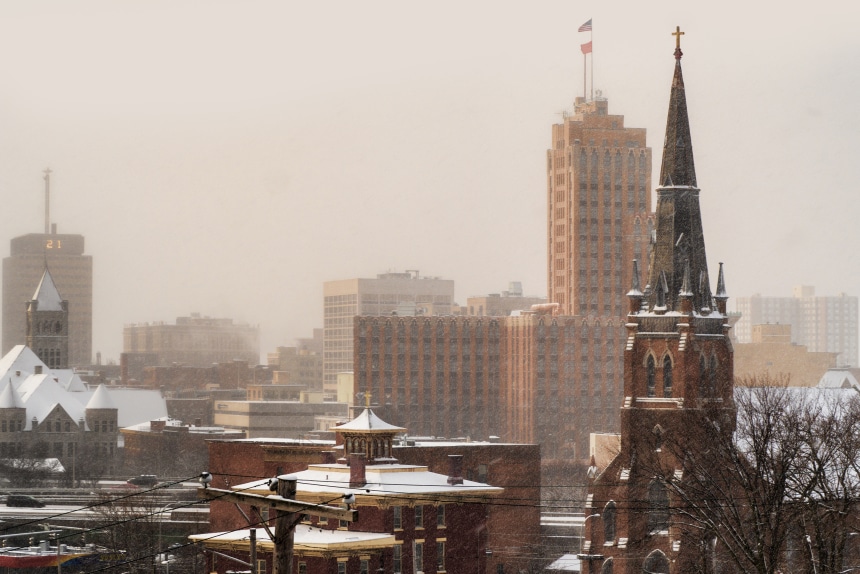
- Average Annual Snowfall: 114.3 inches
- Record One-Day Snowfall: 34 inches on February 15, 1946
Lake effect propels Syracuse easily into the number one spot as the snowiest city in the US. While your much less snowy town might be able to beat Syracuse’s record one-day snowstorm, Syracuse makes up for its lack of blockbuster blizzards with frequent smaller storms.
How and why does this happen? Syracuse is located southeast of Lake Ontario, which resembles an oval tipped slightly up to the east. In other words, there is a “long side” and a “short side” to the lake. The long side runs from near Buffalo, New York, east-northeast to near Watertown, New York. Syracuse is downwind of the short side, which means that when cold Canadian air comes in at the right angle to produce lake-effect snow in Syracuse, it has much less time over the lake to acquire moisture. That’s why the city doesn’t get the same epic blizzards seen in Buffalo.
That said, the snow falling downwind of Ontario’s short side is spread out over a much wider area. That makes it harder for Syracuse to miss out entirely because the lake effect bands are dozens of miles wide instead of just a couple of miles wide.
As a result, Syracuse can pile up inch after inch of snow day after day from November right on through to February, when the lake typically gets too cold to produce a robust lake effect.
Thanks to the lake effect, Syracuse also ranks near the top of the list of the rainiest cities in the US.
2. Juneau, Alaska
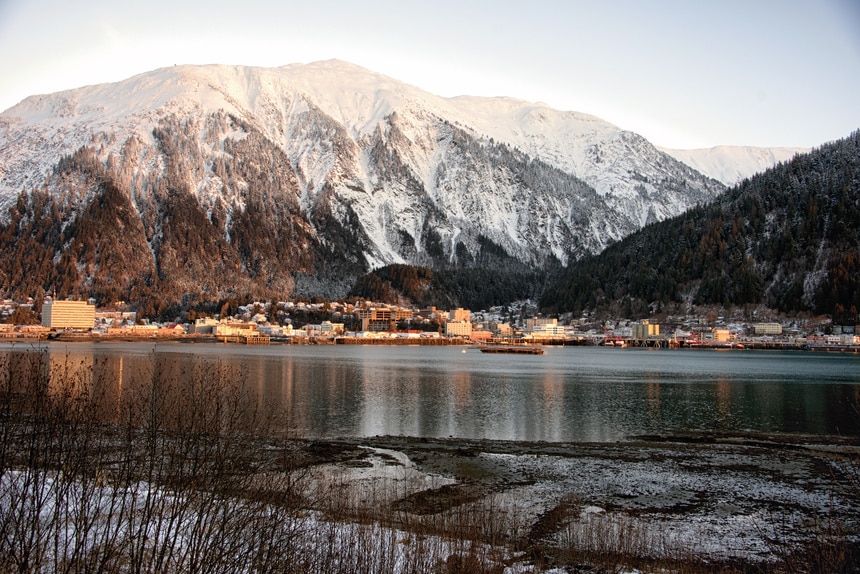
- Average Annual Snowfall: 93.6 inches
- Record One-Day Snowfall: 20.5 inches on April 2, 1963
Juneau is well-positioned for snow in mountainous southeastern Alaska right along the Pacific coast. Moisture is provided by winds blowing across the Pacific Ocean from the west or south. Sometimes, this moisture can come all the way from Hawaii, a phenomenon known colloquially as a “Pineapple Express” storm. Cold air can arrive on a north wind or an east wind from the deep Yukon forests notorious for cooking up cold air masses during the long polar nights. Because Juneau is at sea level west of so many mountains, sometimes the cold air doesn’t arrive in time, and snow becomes rain in the city. Juneau is also one of the rainiest and coldest cities in the US!
Juneau’s fundamental secret ingredient is its mountains. When Pacific moisture smashes into the tall mountains of coastal Alaska, prolific precipitation can fall as the moisture-laden air is forced to rise thousands of feet over just a few miles. As the air rises, it cools, and the moisture it’s holding is forced to condense into rain or snow. The more moisture is available, and the farther and faster it’s forced to rise, the more snow will fall. With all the precipitation falling in Juneau, it means there are plenty of overcast days. Juneau experiences 280 cloudy days per year, making it the cloudiest city in the US.
A secondary source of snow for Juneau is ocean-effect snow that occurs when Arctic air masses spill out of northern Alaska and traverse the Gulf of Alaska. While the Gulf of Alaska is far from a warm body of water, heavy snow can fall, just like in Buffalo or Syracuse, if it’s warm enough relative to the bitter-cold air. Because the Gulf of Alaska is a vast expanse of water rather than a long and narrow lake, the ocean-effect snow has a more challenging time merging into a single band capable of producing extreme snowfall rates. Instead, the snow bands are more numerous, spread out over a wider area, and usually less intense. That’s why Juneau’s record-setting snowstorm is so much lower than Syracuse or Buffalo, weighing in at “only” 20.5 inches.
3. Buffalo, New York
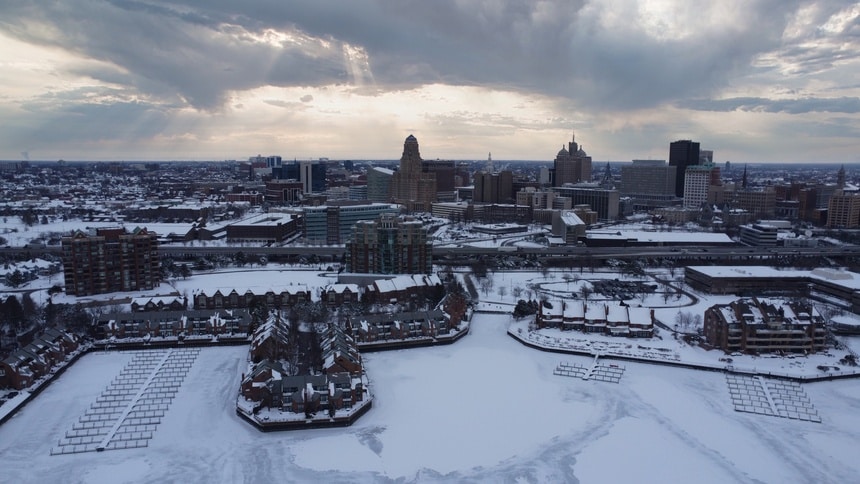
- Average Annual Snowfall: 92.0 inches
- Record One-Day Snowfall: 33.9 inches on December 10, 1995
Like Syracuse, lake-effect snow is Buffalo’s ticket to near the top of the list. You’ve probably read about the city’s propensity for prolific blizzards, including one of the deadliest winter storms during Christmas week in 2022. Because Buffalo is located at the eastern end of Lake Erie’s long axis that stretches all the way to Toledo, Ohio, cold air arriving from the west-southwest has plenty of time to gather moisture and instability before arriving in Buffalo.
The result can be spectacular (and dangerous), very narrow but intense bands of snow falling at two to six inches per hour. These bands can be extremely hit-or-miss, but they hit Buffalo often enough to propel it into spot number three on the list.
While Buffalo’s one-day snowfall total is slightly less than spectacular, its multi-day totals during these long-duration storms can be exceptional. In December 2022, two storms with totals above 72 inches (six feet!) were observed in the Buffalo area, though they lasted more than one day.
4. Rochester, NY
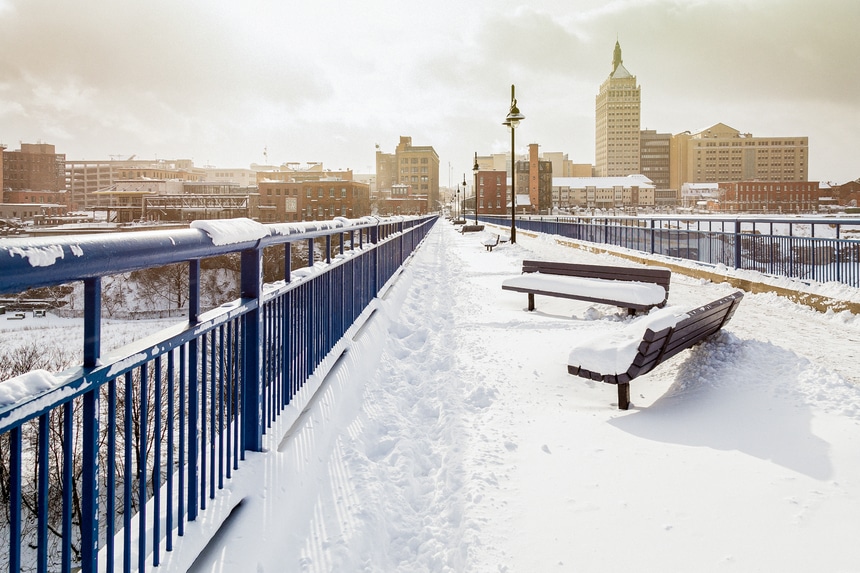
- Average Annual Snowfall: 89.3 inches
- Record One-Day Snowfall: 23.0 inches on January 3, 1996
Rochester also follows Syracuse and Buffalo into the top eleven, thanks to lake effect. Rochester is located farther west than Syracuse, which means there’s even less of Lake Ontario over which cold air can pass before arriving at the city. This distance is one reason Rochester’s largest daily snowfall total is much lower than the other two titans of the New York lake effect.
Those crazy intense bands that blast Buffalo lose a lot of their snow before arriving in Rochester. They don’t get going over Lake Ontario until they’re east of the city. Nonetheless, we measure by average snowfall here, so Rochester’s mix of steady lake effect and the occasional westward-straying nor’easter earns it position four.
5. Flagstaff, Arizona
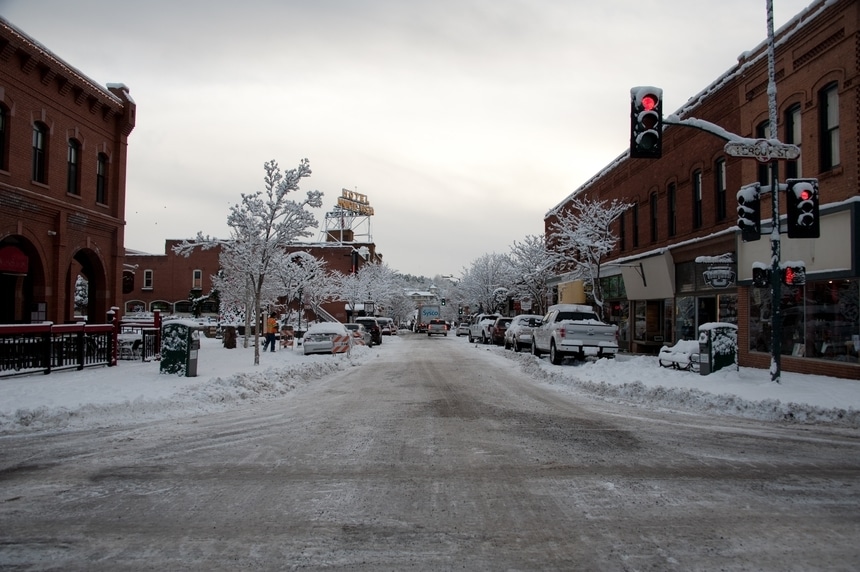
- Average Annual Snowfall: 87.6 inches
- Record One-Day Snowfall: 35.9 inches on February 21, 2019
Moving away from the Great Lakes, Flagstaff takes spot number five with a combination of high elevation (6900 feet, higher than any mountain east of the Mississippi!) and proximity to the Pacific Ocean. Many places in the Rockies get more snow than Flagstaff, but none are cities with more than 25,000 residents.
Flagstaff’s altitude gives it the cold air needed for snow despite its relatively low latitude (it’s as far south as Memphis, Tennessee, and Charlotte, North Carolina). The altitude also helps force air to rise after a long journey across the Pacific, acquiring moisture. With cold air, moisture, and rising air all in place, snow can and does fall frequently. Despite Flagstaff’s significant snowfall total, it actually ranks among the sunniest places in the US.
Before arriving in Arizona, Pacific storms often drop most of their snow over the Cascades or Sierras. Still, sometimes one can sneak through just right and produce prolific totals in a short amount of time. This is what happened on February 21, 2019, when nearly three feet fell in a single day!
6. Binghamton, New York
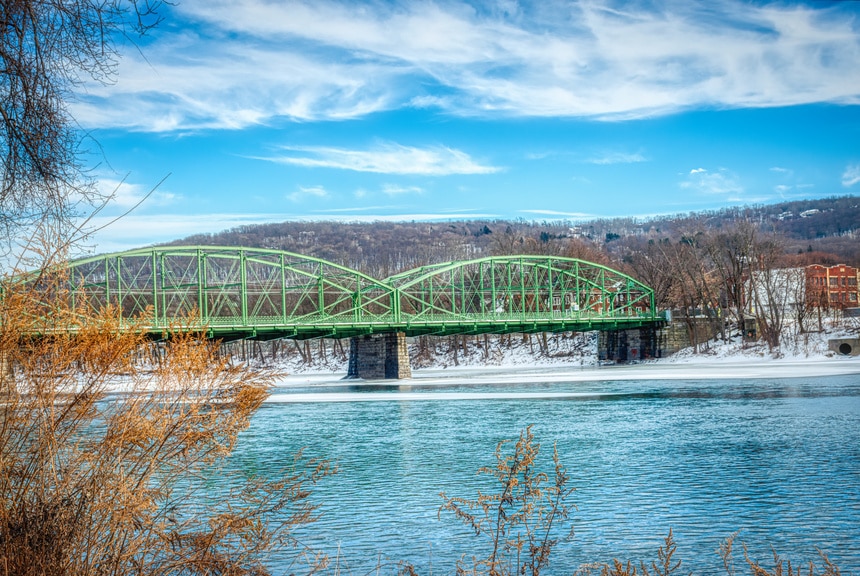
- Average Annual Snowfall: 84.7 inches
- Record One-Day Snowfall: 31.2 inches on March 14, 2017
Back in upstate New York, Binghamton is too far from the lakes to rely on them alone for a path to the top eleven. It’s too far from Lake Ontario to get the prolific storms from Buffalo or even the frequent medium-sized storms in Syracuse. However, enough moisture makes it to Binghamton to combine with its favorable location on the northwest fringe of the Atlantic storm track to earn it a ranking among the snowiest cities in America.
When cold air masses rush out of Canada too far west for lake effect, they can encounter warm water in a different place: the Gulf Stream. The clash between cold air and warm water takes a slightly different form when more than a modest lake’s worth of the latter is available. Instead of narrow but intense snow bands, huge and powerful storm systems can spin up.
As these systems move northeast, they bring cold air in from the north and draw warm moist air in from the south. The warm air, being less dense, is forced to slide up and over the cold air, fulfilling all the ingredients needed for snow. Binghamton is just close enough to the Atlantic to cash in on these coastal storms as it did on March 14, 2017, when it recorded a record-setting 31.2 inches of snow in a single day.
7. Duluth, Minnesota
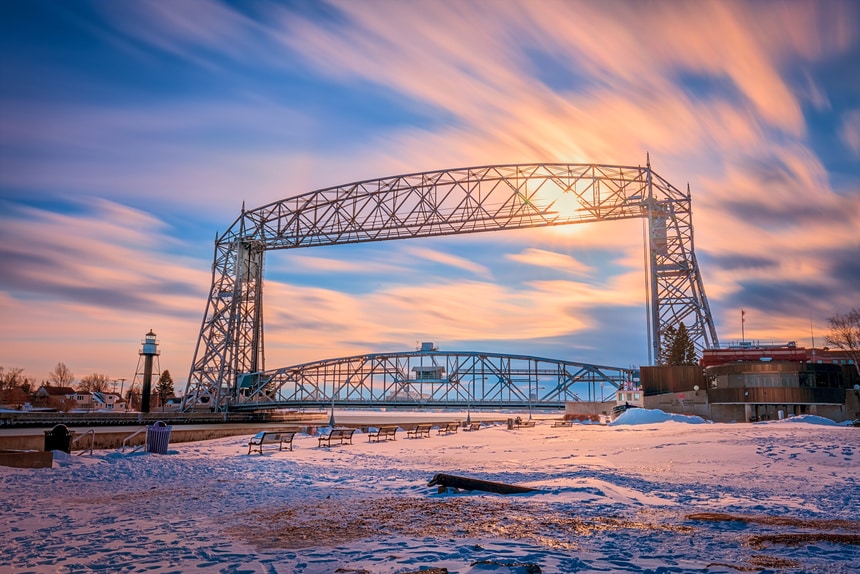
- Average Annual Snowfall: 83.5 inches
- Record One-Day Snowfall: 24.1 inches on November 1, 1991
Duluth is a special case as it sits on the western side of Lake Superior and is far from any other source of moisture. Unlike Lake Erie and Lake Ontario, though, Superior is big enough and far enough north to produce a lake effect along all of its shores (though the southern and eastern shores are still most favored). The result is a ticket to the top eleven, with the help of strong storms that track farther inland during the spring and fall. One such Gale in November 1991 produced Duluth’s record snowiest day, with two feet of new accumulation recorded.
8. Erie, Pennsylvania
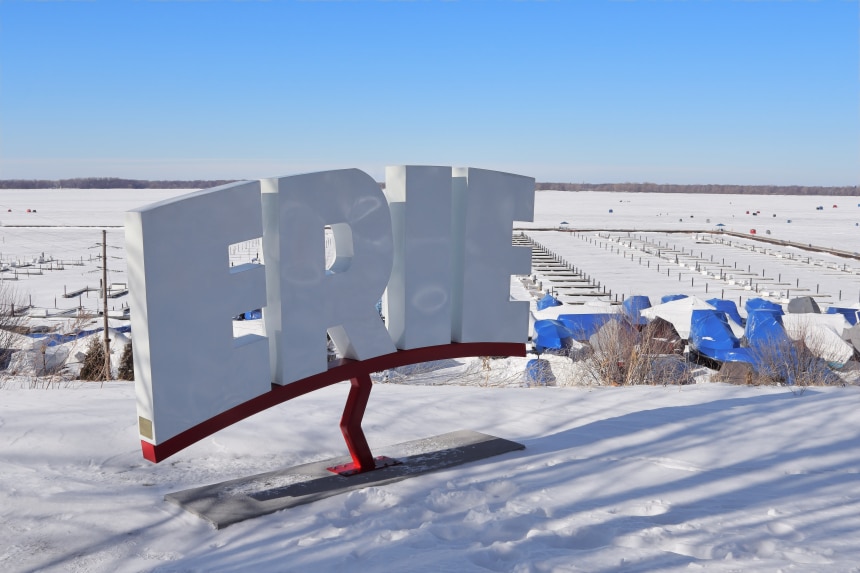
- Average Annual Snowfall: 80.9 inches
- Record One-Day Snowfall: 21.8 inches on December 26, 2017
Like Syracuse and Rochester, Erie earns its spot on the list with many days of light to moderate snow rather than prolific individual blizzards. This is due to its location about halfway down the southeastern shore of Lake Erie. It means that cold air crossing the lake en route to the city can only do so across the shorter axis of the lake, though there’s still enough time to add moisture and some instability to the air so it can rise and produce snow.
Erie’s one-day snowfall total of 21.8 inches on December 26, 2017, isn’t all that impressive for the exact reason mentioned above. But it was immediately preceded by the city’s second snowiest day on December 25, 2017, when 20.9 inches was recorded. When it snows in Erie, it doesn’t usually do so as intensely as in Buffalo, but it can keep going for quite a while!
9. Burlington, Vermont
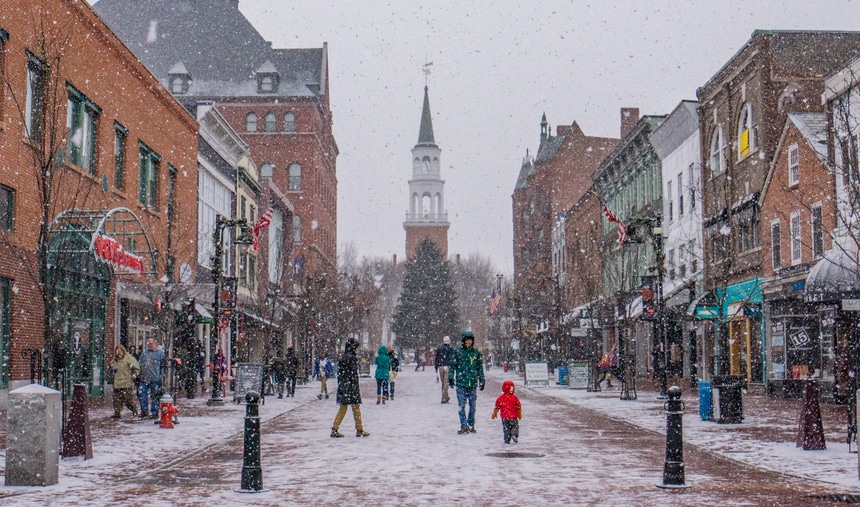
- Average Annual Snowfall: 80.2 inches
- Record One-Day Snowfall: 25.3 inches on February 14, 2007
Still in the Northeast but far from any Great Lakes, Burlington notches a spot in the top eleven by capitalizing on those intense coastal storms that form off the East Coast during the winter. These storms usually stay too far east to bring huge snowfall totals to Burlington, but the snow can pile up when they stray a bit west. That happened on Valentine’s Day in 2007 when the city saw 25.3 inches of new snow.
10. Muskegon, Michigan
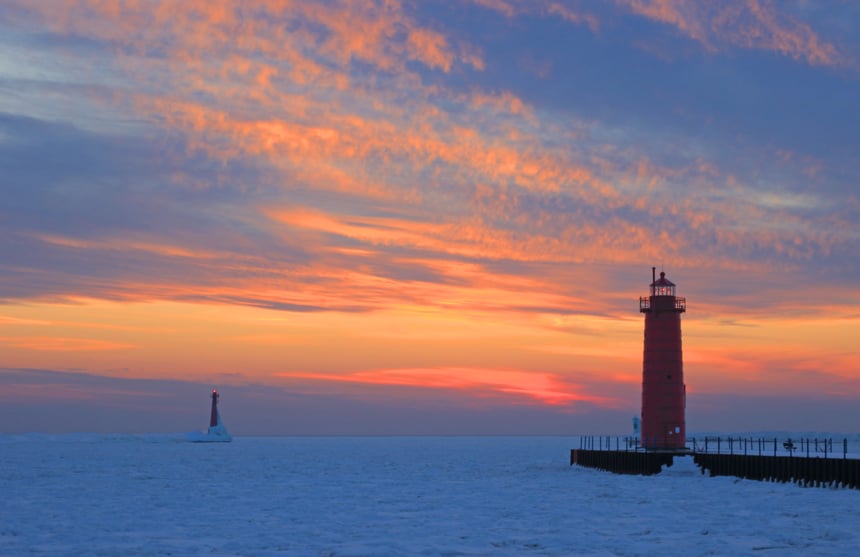
- Average Annual Snowfall: 79.3 inches
- Record One-Day Snowfall: 22 inches on January 10, 1982
Nestled halfway up Lake Michigan’s eastern shore, Muskegon earns a mention the same way Erie, Rochester, and Syracuse do: lots of days with light to moderate lake effect snow. Because winds rarely blow from the north-northeast right down Lake Michigan’s long axis, the lake isn’t known for the same kind of prolific blizzards that its neighbors to the east can produce. That said, it doesn’t take much for the lake effect to happen in Muskegon, and the net result is enough snowfall to combine with more typical nor’easter-like winter storms for Muskegon to take spot number ten.
11. Casper, Wyoming
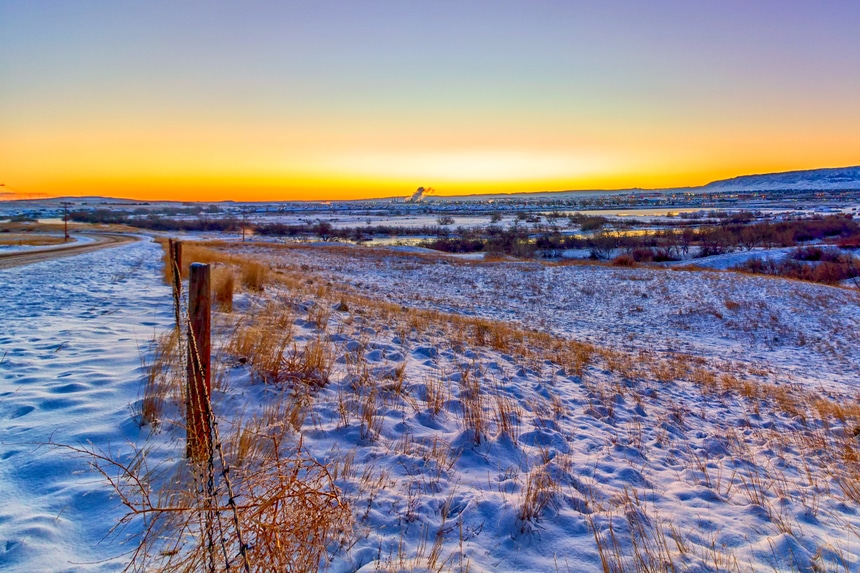
- Average Annual Snowfall: 77.0 inches
- Record One-Day Snowfall: 24.3 inches on December 24, 1982
Located east of the Rockies in the high steppe of Wyoming, Casper doesn’t enjoy the same natural advantages as many of the other snowiest cities on this list. Most notably, there’s no nearby source of moisture readily available to be turned into snow. The Pacific sits behind five hundred miles of jagged mountains eager to take the snow for themselves, while the Atlantic is two thousand miles to the east.
However, especially during the spring, moisture traveling north from the Gulf of Mexico can combine with cold air from Canada to form powerful storm systems in the Great Plains. The track of these storms often places Casper in the snowy northwest sector, where enough snowfall accumulates to round out our list as the eleventh snowiest city in the United States.
Casper also ranks fifth on our list of the windiest cities in the US by annual average wind speed. The combination of snow and wind can be extremely treacherous for interstate travel. Highways across Wyoming are routinely closed and clogged with wrecks.
Honorable Mention: The Snowiest Places in the United States Are Mount Rainier and Mount Baker
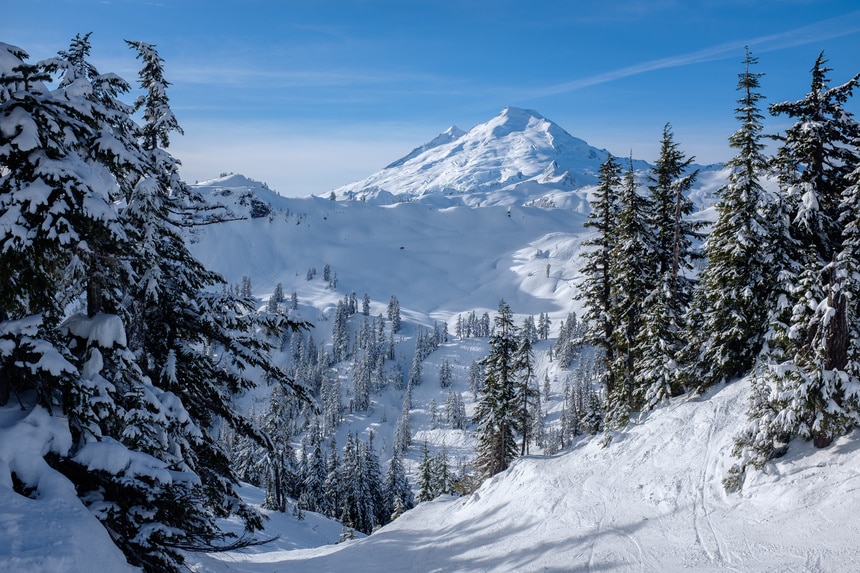
What about the absolute snowiest place in the whole country? At least among places where humans are around often enough to measure, Mount Baker, Washington, is the snowiest place in the United States. In an average year, the ski area on Mount Baker picks up a whopping 654 inches of snow, but that’s just the annual average snowfall. Its snowiest year on record was 1998-1999 when the mountain recorded 1,140 inches of snow! That also happens to be the current record for the snowiest winter season anywhere on the planet.
An honorable mention in the snowiest place race is the outpost of Paradise on the slopes of Mount Rainier, Washington, which records an average of 640 inches of snow annually.
How could it possibly snow that much? Mount Baker and Mount Rainier are tall volcanoes in Washington’s Cascade Mountains. They have the absolute perfect combination of access to ingredients for snow. The high elevation of the mountains means cold air is rarely a problem. They’re within sight of the Pacific Ocean, so there’s rarely a moisture shortage. And for moisture to reach the summits, it must ascend more than ten thousand feet over just a few miles. Talk about rising air!
Amazingly, neither the Mount Baker ski area nor Mount Rainier’s highest National Park outpost (Paradise) is located at the summit of their respective mountains. If you could make it to the very top with a yardstick (or ten), you’d find even more snow! However, this is not advised, as the mountains are extremely dangerous in winter. Avalanches are very common on the steep snow-laden upper slopes.
Final Thoughts
Snow is one of the atmosphere’s greatest joys (or perhaps the most annoying curses), and few phenomena capture the imagination as it can. It can snow almost anywhere in the country (even Miami, Florida, has recorded a few flakes!), but the Great Lakes overwhelmingly dominate the top eleven list of snowy cities. That’s due to the lake effect, one of the atmosphere’s most efficient snow-producing machines. While the Rockies, and the Cascades, are better at cranking out flakes, very few people live high enough in the hills to see (and measure) it.
This list is compiled using data from the National Centers for Environmental Information’s Comparative Climatic Dataset. This dataset uses information spanning from the late 1940s or early 1950s (depending on the station) until 2020, ensuring a long period of reliable data with which to make comparisons. Record snowfall totals are taken from Extreme Weather Watch, which compiles record-setting weather events.




